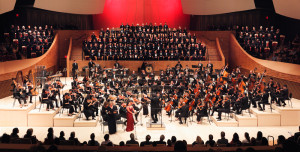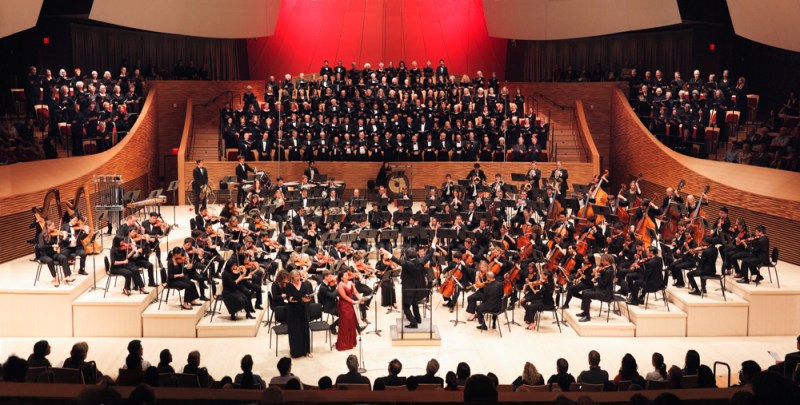
Chen Zhao sits silently in the empty stands of Bing Concert Hall, his eyes focused on the bow strokes of the string players as the Stanford Symphony Orchestra rehearses Mahler’s Symphony No. 2.
Zhao sees when a single violinist isn’t putting enough “vibrato,” or vibration, on the string—or is playing at the wrong end of the bow. Not too many people know the bow strokes for this symphony better than Zhao, a violinist who has recorded Mahler’s almost 90-minute work with the San Francisco Symphony.
When he spies these deviations, Zhao picks up his violin and jumps into an empty seat in the violin section to play along, showing the college musicians how he approaches the music.
Symphony flutist Catherine Payne makes similar demonstrations for the woodwind section and can be seen waving her arms in explanation while conductor Jindong Cai runs the rehearsal. Payne and Zhao are “encouraging individuals,” said Anna Wittstruck Ph.D. ‘15, assistant conductor of the Stanford Symphony Orchestra.
“It’s very easy to feel lost in a group of 110,” Wittstruck said.
For the first time, funding from a portion of the $500,000 Andrew W. Mellon Grant awarded in 2011 to Stanford’s performing arts organization Stanford Live brought musicians from the San Francisco Symphony and the San Francisco-based Philharmonia Baroque Orchestra to Stanford to coach its orchestra last quarter.
Sessions will continue this quarter as the symphony prepares Verdi’s Requiem, but the orchestra will have more sessions from San Francisco musicians next quarter as they prepare Kurt Weill’s sung ballet “The Seven Deadly Sins” and Tchaikovsky’s Symphony No. 4—a work which the Stanford Symphony Orchestra will watch the San Francisco Symphony perform this February.
Stanford Live uses the funds to hire guest artists, debut compositions by music faculty and support students in designing opening acts for shows at Bing, according to Ben Frandzel, the organization’s institutional gifts officer.
The grant compensates musicians at competitive rates, said Wittstruck. But she noted that this isn’t the only reason musicians come to Stanford to coach—they want to teach students who are headed for diverse careers, but who are also very talented musicians.
Stanford Live executive director Wiley Hausam plans for the grant to support coaching sessions again next year. When the funds are spent after the 2014-15 academic year, individual donors will likely provide enough funding to support the coaching sessions, he said.
Although professional musicians have given coaching sessions through the music department before, the Mellon funding allowed for almost every section of the orchestra to receive individualized coaching—from professionals who had expertise not only with the instrument, but also with the piece.
For example, the San Francisco Symphony has recorded all nine of Mahler’s symphonies, and several of these recordings have won Grammies. From this symphony, Wittstruck hired a violinist, a violist, a cellist, a flutist, an oboe player, a bassoon player, a horn player and a trumpet player.
“There’s really no one better to go to for Mahler than the San Francisco Symphony,” Wittstruck said. “That’s what they do.”
Courtesy of Joel Simon
Heavy on the Mahler
French horn player Stephanie Palocz ‘16 had great expectations for the sectional with Robert Ward, principal horn of the San Francisco Symphony. Ward has played first horn on all of San Francisco’s Mahler recordings.
“I go to see the San Francisco Symphony a few times a quarter, whenever I can,” Palocz said. “And I admire his playing a lot, so it’s really cool to kind of get some tips.”
As the sectional approached, the horn players knew their parts, but still had specific questions about the piece. When section members got to Braun Rehearsal Hall for the sectional, everyone was “on the ball and ready to go,” said horn player Rebecca Gruskin, a second-year doctoral student in the history department.
Ward, too, was all business. He sat down in front of the section holding a copy of the score, which includes six separate horn parts for nine horns, and had the section play through the entire piece. When he occasionally stopped the horns, Ward gave succinct advice, which applied to the particular difficulties of the instrument.
For example, few people who are not French horn players would be able to explain the best fingerings for a technique called “stopped horn.” Players must put a hand in the bell of the instrument to make a more muted, metallic sound a half step above normal pitch. To lower the pitch again, they must change their fingering
“He knew exactly where to go and what sort of problems we might encounter,” said horn player America Reyes ‘14.
There’s a passage at the beginning of the Mahler using this technique that is very difficult to get in tune, Gruskin said.
But Ward has a “little chart” in his head of the best fingerings to use in different situations, he said. Ward suggested these alternate fingerings to the section.
One rehearsal later, the horns played the “stopped” parts in tune for the first time, Gruskin said.
Students also said they appreciated how they were able to play the piece with more awareness of the composer’s ideas after the sessions.
Clarinetist Richard Wang Ph.D. ‘16 said that, drawing from their experience, San Francisco coaches advised woodwinds to play with volume and expression to capture the varied moods of Mahler’s work.
“Always exaggerate what you’re playing,” he recalled being told. “Because the audience hears a lot less than you think.”
Future collaboration
Zhao has worked with Wittstruck on several performances in the past few years, and they often spoke about bringing members of the San Francisco Symphony to work with Stanford’s orchestra. Zhao established the connection last year when he coached through the music department.
Zhao said he benefited from stepping out of his performance element and teaching the college musicians, as he’s not usually as aware of how he translates musical ideas into technique—this awareness makes him a better player.
Ward also said he would like to work with the Stanford musicians again.
Ward, who has coached at music festivals and is on the faculty at the San Francisco Conservatory of Music with Zhao, said he appreciates college students’ enthusiasm for learning new pieces.
“It was really fun to be a part of that energy,” he said when he coached at Stanford this fall.
Contact Andie Waterman at andiew ‘at’ stanford.edu.
A previous version of this article referred to the Stanford Symphony Orchestra as the Stanford Orchestra and said that the Andrew W. Mellon Foundation spent the grant funds for Stanford when in fact it was spent by Stanford Live. The Daily regrets this error.
